It seems like everything is outrageously expensive nowadays, from the prices of new cars to rates at public charging stations. If you’re looking to escape the squeeze, I just found a car that claims to get as good gas mileage as a small motorcycle. This is the XR-3, and it’s somehow the best and the most shocking car-thing that you’ll see in a while. It has a turbodiesel engine and gets 125 mpg, but just look at it.
Amazingly, this car was not exactly a one-off, but a kit car, and it’s somehow even crazier than the lede suggests. The XR-3 was marketed as a diesel-electric plug-in hybrid. When equipped as a hybrid, this thing is supposed to get a combined 225 mpg.
I have found what appears to be the only XR-3 for sale in America out of who knows how many were ever built, and I’m sort of shocked at the whole thing. This car is like a homebuilt version of the Volkswagen XL-1, but with a body closer to that of the HMV FreeWay and a top speed apparently as high as 80 mph. Let’s jump into it!

Creator Of Many Things
The XR-3 was the work of Robert Q. Riley Enterprises, LLC., a green vehicle company located in Glendale, Arizona. Chances are, if you’ve read Popular Mechanics or Mechanix Illustrated at any point in the past half-century, you’ve seen one of mechanical engineer Robert Q. Riley’s ideas, and oh my, he had lots of them. Let the folks of 3-Wheelers.com bring you up to speed:
Robert Q. Riley Enterprises was founded in 1986 by Robert. Q. Riley as a Design Consultancy who specialise in Product design and development. Along with a number of other innovations the company has also created a number of 3-wheelers that are sold as plans ready for the owner to build them selves completely from scratch.
The first of these was the Trimuter, this first appeared on the cover of Mechanix Illustrated magazine in February, 1980 and was also used as a back ground vehicle in the film Total Recall. The Trimuter is powered by either an electric engine or a 16-hp, two-cylinder industrial engine. (The electric version uses ten 6v batteries) The body is a fibreglass / urethane foam composite and houses a two seater cabin.
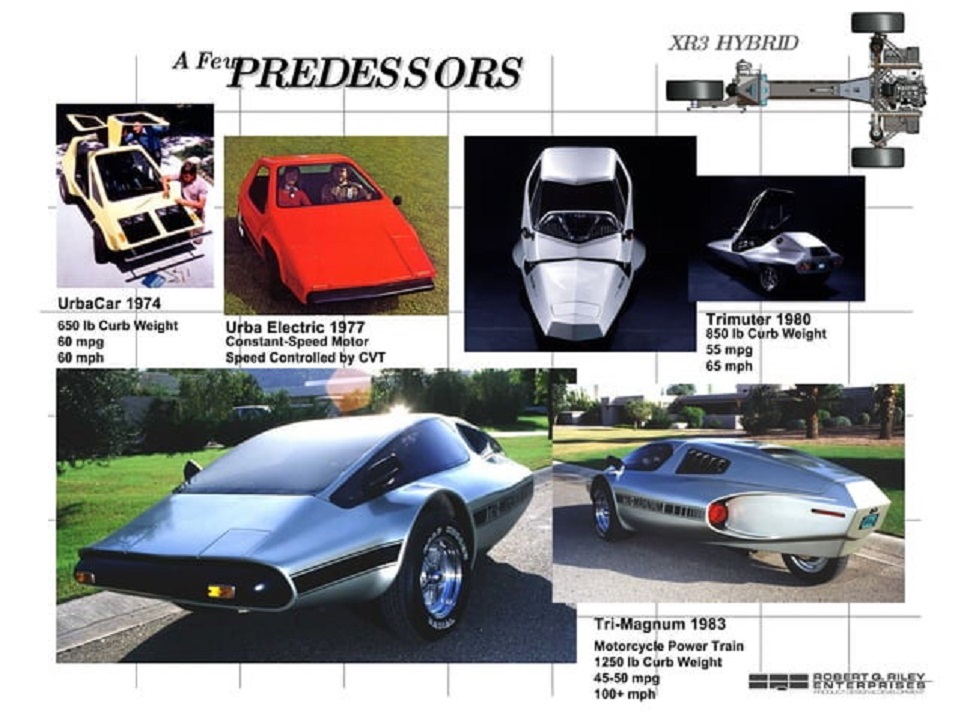
The Tri-Magnum which was designed as a high performance 3-wheeled sports car and was first featured in Mechanix Illustrated magazine, February 1983. The original Tri-Magnum was powered by a Kawasaki KZ900 motorcycle engine though this has now been changed to the Honda Gold Wing engine as this features an electric reverse facility. The chassis of the Tri-Magnum is a stripped motorcycle chassis minus the fork and front wheel. This is then attached a VW Beetle front suspension assembly using a simple framework. The body is a “sandwich” of urethane foam and fiberglass bonded together and houses a two seater cabin with seats side by side. In addition it also features a lift up canopy which has a steel framework embedded into it. Steering is via handlebars whilst gear change is by a “jet-fighter-style control stick” that emerges from the floor.
Riley was known best for his trikes, one of which I have written about before, but his scope was far greater. As a biography on his now-offline website says, Riley designed GM’s Drive I electric car in addition to boats, kit-built single-person submarines, a camper van, a backpack helicopter, and even a homebuilt hovercraft.
The XR-3 Hybrid

Riley wasn’t just a dreamer, either, as these kits were sent out into the wild, and people have built them. Sadly, Riley passed in 2021. He was still working and dreaming when he passed, and one of his projects was the XR-3, a trike that he had been developing since the mid-2000s. How old is the XR-3 project? Mike Spinelli wrote about it on Jalopnik in 2007!
Back then, here’s the press release that Riley sent out:
Fuel-Efficient XR-3 Will Offer 125-225 Miles per Gallon
In less than 90 days, Robert Q. Riley Enterprises, LLC, a product design firm in Glendale, Ariz., will introduce its XR-3 plug-in hybrid, a sleek two-passenger, three-wheel sports car that is expected to generate up to 225 miles per gallon. Designed to be assembled by someone with average mechanical abilities and no prior experience, the all-wheel drive vehicle will be available as a kit or plans for complete do-it-yourself construction.
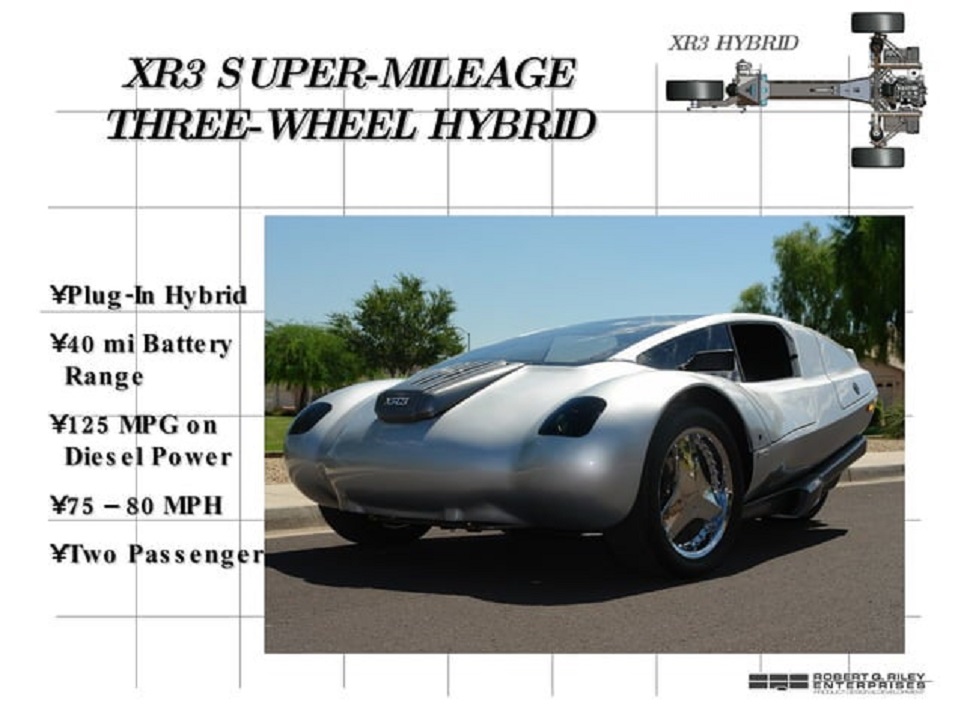
“We’ve made a technology leap by designing a super-simple hybrid power system, but ‘technology’ itself was not the main thrust of the project,” said Robert Q. Riley, company president and author of “Alternative Cars in the 21st Century.” “We focused on the power of ‘design’ to define a new category of personal mobility products that are neither automobiles nor motorcycles.” The XR-3 uses the latest hybrid power system technologies in the most simplified way possible. While the front wheels are powered by a three-cylinder diesel engine, a single rear wheel uses an electric motor run by a lithium-ion battery. The ground provides the connection between the two systems, eliminating the need for a complex electronic and mechanical interface.
Driving on power from its diesel engine, the XR-3 can achieve fuel economy of 125 miles per gallon. However, when the diesel and electric power systems are combined in a hybrid driving mode, fuel economy can exceed 200 miles per gallon over an 80-mile trip. A simple three-position switch allows the driver to select between battery-only, diesel-only and hybrid driving modes. The diesel engine can remain off for local trips, since power from the advanced lithium-ion battery pack gives the car a battery-only range of up to 40 miles.
While the XR-3 was marketed as a hybrid, it was really a vehicle with two completely separate powertrains that do not interact with each other. If you built the base car, you fitted your XR-3 with Kubota D902, a 898cc three-cylinder diesel good for up to 24.8 HP depending on exact configuration. This engine transmitted power to the front wheels through a VW Type 1 transaxle.

If you wanted to go all the way, Riley also marketed the XR-3 as having the option to sport lead-acid batteries or lithium batteries, which would power an eight-inch DC motor that drives the rear wheel. As a diesel-only vehicle, Riley said, you’d get 125 mpg. Add the electric motor and batteries, and Riley said you’d hit 225 mpg. He also said that if you built the diesel version with a large enough fuel tank, you could go 1,000 miles per tank. On the other hand, if you went with a big lithium battery, Riley said, you could get the trike to go 100 miles per charge.
Riley also said that if you built your trike as a diesel-only car, it would weigh 950 pounds. But as a hybrid with the electric motor, batteries, and the diesel engine, the total weight was projected to be 1,480 pounds. The average specification, Riley mentioned in press releases, would be able to travel 40 to 50 miles on a charge, or 375 miles on only three gallons of diesel. In 2008, the batteries were said to be able to recharge in 8 hours. Today, the company that sells the kit says that an XR-3 trike with a modern lithium battery can charge to 80 percent in less than an hour.

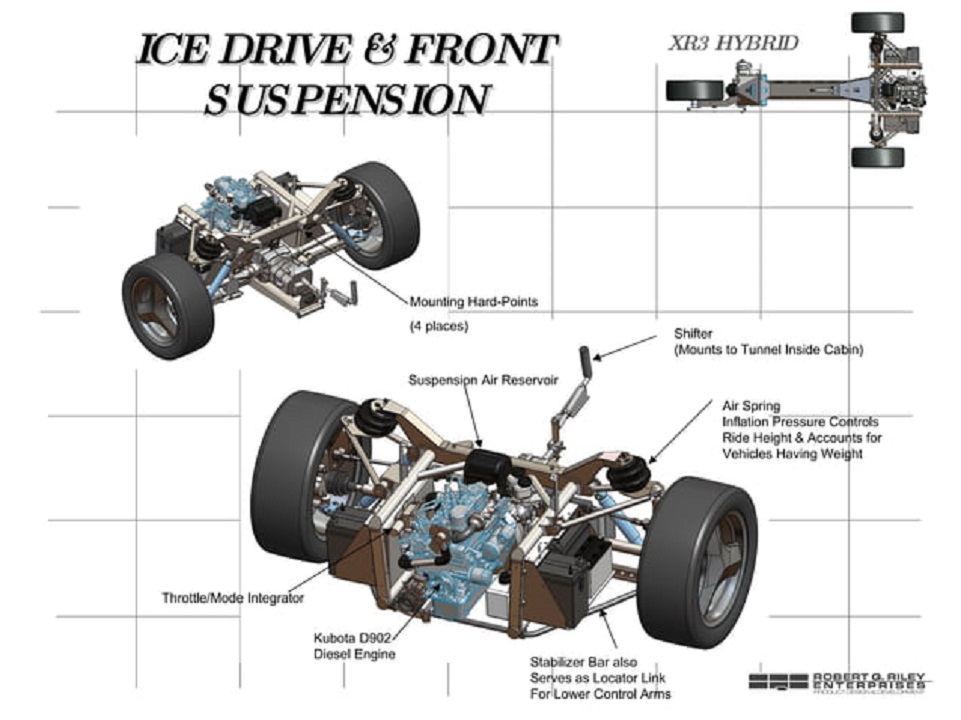
Riley and his team built a single prototype in 2008 and began marketing the XR-3 as a kit car or as a turn-key car that you could buy. Apparently, the guys who built the body of the prototype had never even worked with fiberglass before. According to the press material, anyone with basic construction skills should be able to complete an XR-3, and it should take about 650 hours to finish the build. Riley said that it cost $25,000 to build the prototype, which had lithium batteries and a diesel engine. In 2010, he estimated that a compatible lithium battery would cost $9,000, while an alternative equivalent lead-acid solution could be $2,000.
So then, you’re probably wondering why the XR-3 on your screen today looks nothing like the prototype.
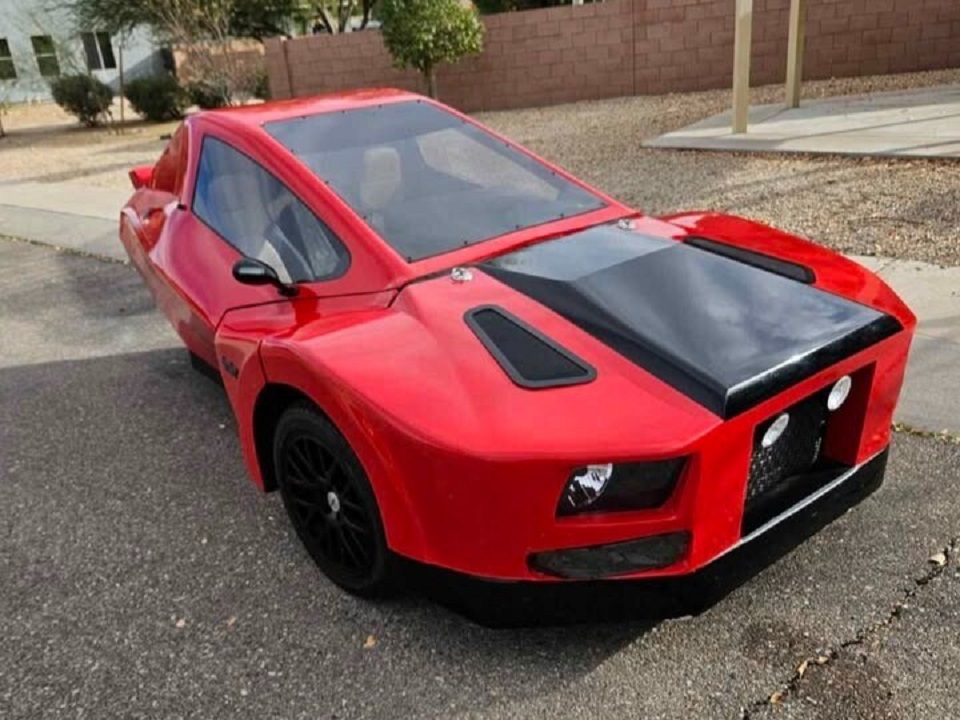
After all, Riley’s idea was that you could buy the whole body and maybe even the vehicle’s steel frame if you wanted to, so you wouldn’t have to mess around with fiberglass or make your own structure. 3-Wheelers.com interviewed Riley and found out that Riley was $25 million short of putting the kit into production. In the meantime, Riley sold plans and instructions to build your own XR-3 on his website.
Unfortunately, Riley passed before these parts could enter production. So, if you buy plans and instructions, you’re entirely on your own for the end result.
This XR-3
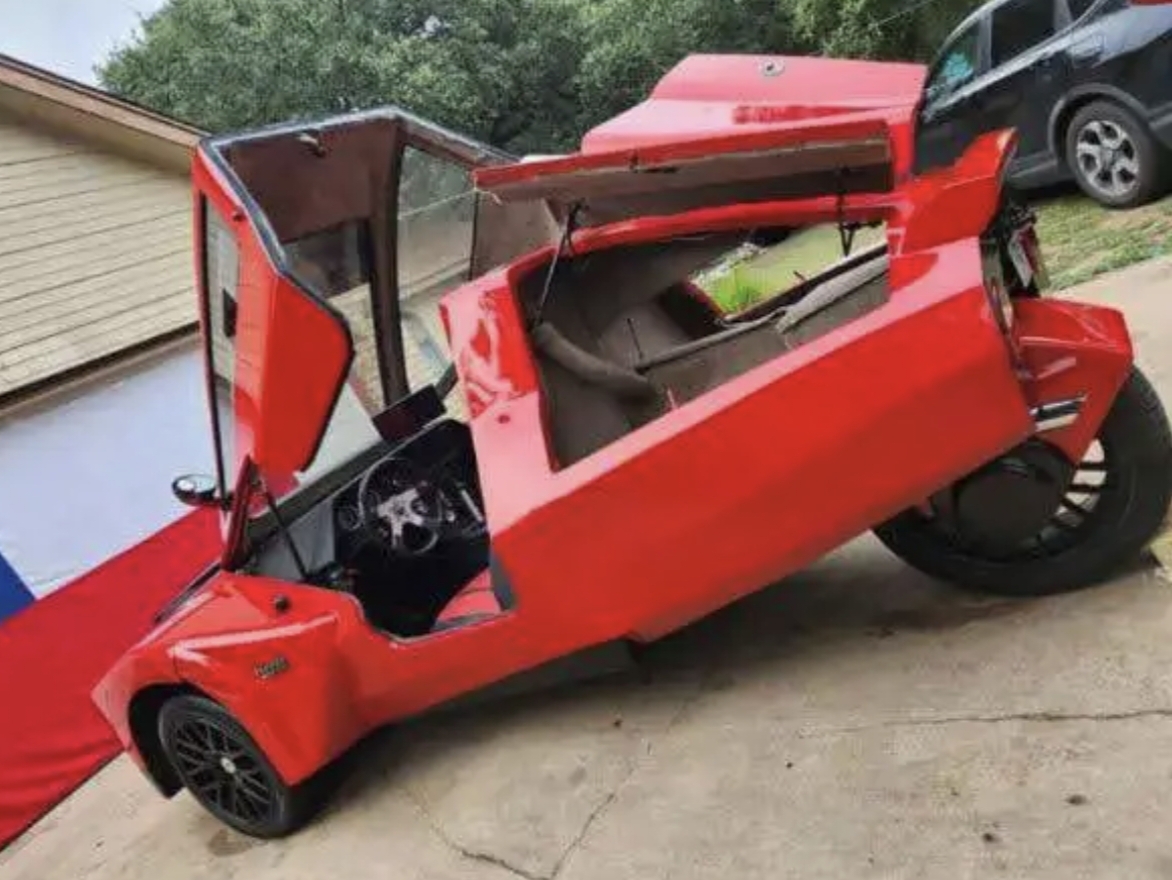
That brings us to the 2019 XR-3 that’s for sale on Facebook.
As you can tell, it looks nothing like the prototype. It’s also somewhat short on the features of the prototype. This one isn’t rocking the dual drivetrain, but instead has just the Kubota diesel, which is spinning the front wheels.
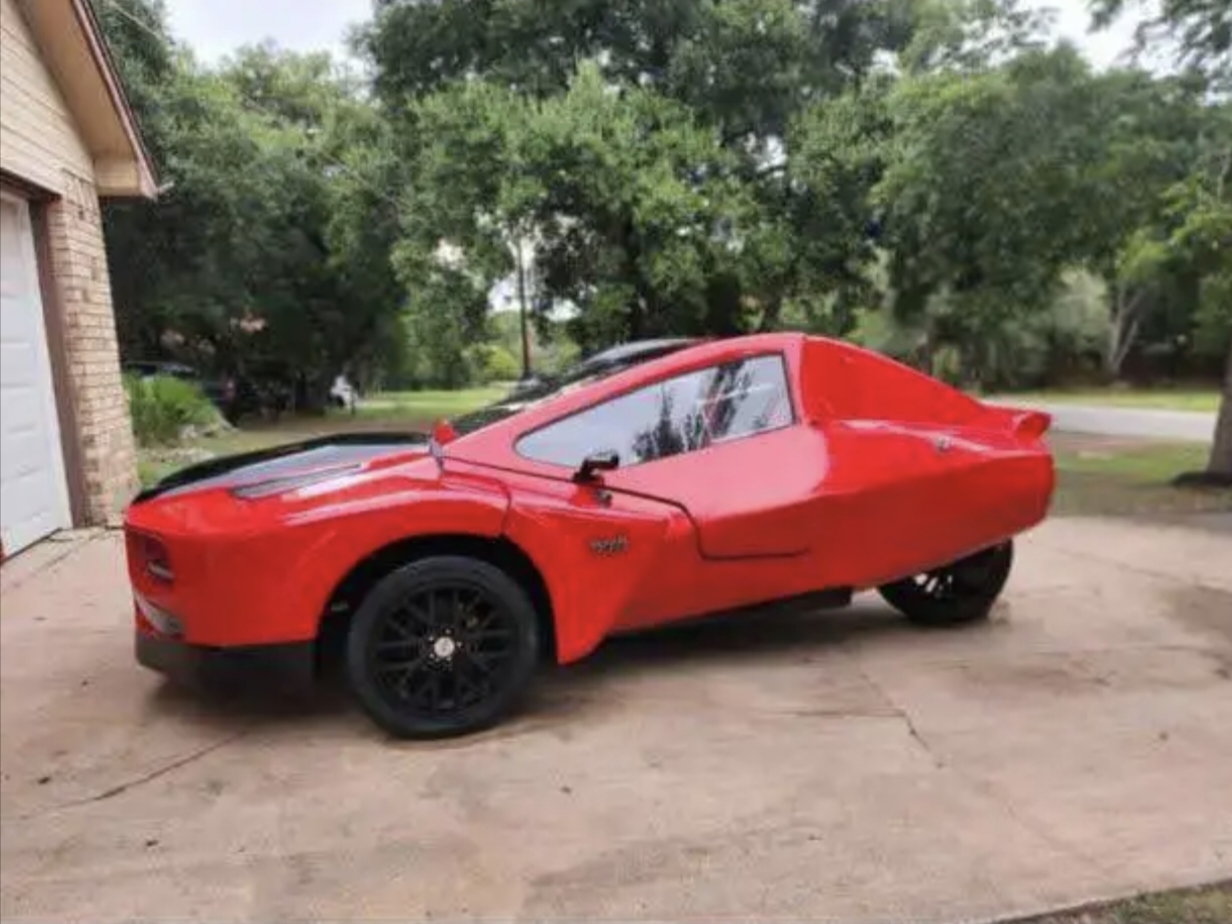
This car was first put up for sale a year ago in Arizona. The buyer of the vehicle moved it to Manchaca, Texas, and put it up for sale quickly. It’s still for sale a year later. Here’s what the original listing stated:
Selling this XR3 reverse trike for the widow of a friend who built it himself.
He was a Raytheon engineer who had built 2 of these previously. This is a full body reverse trike powered by 4 cylinder Kabota Turbo diesel engine. It has a 4 speed transaxle with rack and pinion front wheel staring. The suspension includes double air lift bags and coilover shocks. Hydraulic disc brakes, rear view camera and air conditioning.

Apparently, the original builder spent $21,800 putting this car together, and then drove it only 700 miles after completing it. The seller says that he has every single receipt from the build process, as well as a container filled to the brim with documentation and even a DVD about how the original builder put the car together.
What’s pretty cool to me is that this thing has heat and air-conditioning, which isn’t something that you often see in homebuilt cars. That body is pretty wild, though. It looks like the builder roughly followed the shape of the prototype, but it didn’t come out the other end nearly as rounded. I won’t dare to say whether this thing is pretty or ugly, but I will say that I admire what the builder accomplished, considering that Robert Q. Riley Enterprises did not produce a proper body for its kit car.



The DIY nature of the car continues inside, where there’s little in the way of refinement. You can see exposed fiberglass all over, the steering wheel isn’t much to write home about, and the transmission gearshift seems like an afterthought.
So, this thing is all kinds of weird and sort of off-putting, but I dig it. The seller wants just $6,500 for it, too, which doesn’t seem that bad!

I think this car is the perfect example of the slang term “blursed.” It’s blessed and cursed at the same time. Cursed because, if you squint really hard, it’s sort of the poor person’s version of a Volkswagen XL-1. Blessed because, apparently, this car does get over 100 mpg. Riley sort of pitched the XR-3 as a cool way to save money at the pump and reduce your carbon footprint while having a ton of fun, and you know what? I believe it.
This is the kind of vehicle that everyone is going to stare at and everyone is going to ask questions about. Handling? Well, I suppose that’s going to be on the builder, but there’s still fun in building your own car and then trying to see if you can get it to do well over 100 mpg. If anything, I want to see more cars like these. They’re different, and that’s neat!









Load it down with federally-mandated safety equipment, crash protection, and emissions controls, and it’ll get 1/3 the original fuel economy: The Malaise Falcon.
In the vein of movie references, I was really hoping the excavator diesel would turn out to be a Caterpillar so I could be Sean Connery.
There is someone at our local weekly car gathering who did the opposite. Too a modern Corvette drivetrain and fit a Falcon body on top. Did arelly decent job with it as well.
A “green car company”… building a diesel
carthing?Weird but fascinating car!
gtu
Weird but fascinating car! Hard to believe something this odd could hit 125 mpg.
I mean, isn’t that true for any car?
If I put a 60 gallon tank in my Sienna it’ll go 1000 miles per tank!
Elio, meet your father. I’m still waiting for my freaking $100 Elio deposit refund BTW.
I’m sorry for your loss.
Looks good but I’m holding out for an Elio. Last I heard they’re getting an engine source lined up and they expect to be up and running by mid-year.
Sorry, 650 HOURS to build?!?! Who would have that kind of time? No wonder not many were built.
I wonder if the 650 is actual or Kit hours. Because there is a difference. Kit Hours is how long a professional mechanic with a full set of tools and experience with the build can assemble the kit if they focus on the build 8-10 hours a day, 5+ days a week. For someone without the tools, experience, and available hours, the actual hours are longer
If 650 is Kit hours, then I figure this thing that was a kit around 25 years ago is about right for being just finished.
A+ would hoon
How would you register a kit car? Does it get a vin? It would have to right?
I’m eagerly awaiting Toecutter’s take on this.
It is common to use a clear title/vin of a donor, normally of the drivetrain . Maybe VW Beetle in this case since it has transaxle and front suspension. See Toecutter’s response below.
I wonder what generation Kubota that is because the emissions compliant ones of today (Tier 4) probably don’t package as well or get that kind of fuel economy.
Gonna vary by state law. This could be under the rules of the year of build, the year of some vehicle it is based on, or completely exempt depending on the rules of your state.
What’s a “predessor”?
Good eye! Riley’s site had quite a few spelling errors like that…
And shite design, and terrible kerning…
I’m guessing line spacing is unleaded. I’ll see myself out.
I’m not sure that the person responsible for that website is even familiar with the term “kerning”.
Yeah, that site is a bit of a train wreck. Like, I can look past a misspelling in a text or social media post or whatever, but on your company’s website? That’s a bit more difficult to ignore.
Foam sandwich composites are probably the easiest way for garage builders to “make bodywork” for kit cars and projects. You can control the weight and rigidity by using different fabrics and layer counts.
The only “hard” part is making the foam sculpts, really – at least, for me who is bad at freehanding stuff and having it match. It’s how I made the bodywork for the chibi-Mitsubishi van go-kart.
(It’s also how I plan to make my Slate-based van once it comes out)
There are so many strange 3 wheelers that came out of the mid to late 2000s. I think that might be partly why canam made the reverse trike and Polaris the slingshot. People got so hyped up for these things. I think there is still an open source 3 wheeler they are 3d printing and maybe some carbon fiber glass. $6500 seems like what these guys always want despite always claiming to have spent $25k to $30k building the thing. I think when it comes down to it they are just to rattly noisy and scarry for the people who built them. There is a reason kit cars come with a frame building one unless you have an absolutely level shop and are a good welder is going to turn out not great. There are always exceptions for extremely talented welders but the vast majority of people who want to build these things are not that. Still the little 3cyl diesels you can get off reefer units or apus can be good cheap power with crazy fuel efficiency in many platforms.
So, some guy in his garage can knock this together and RQE needed $25 million to get a kit in series production, and Elio effed around for over a decade and burned through about $150 million and fabricated only a half dozen or so crude prototypes.
Would have been better off buying the rights to one of RQE’s existing designs and tooling up for assembly line production of it
I have a set of tri-magnum plans upstairs collecting dust. Every winter I think about hacking my zg1000 or Burgman up and building a tri-magnum. The details on how to make a foam unibody sandwich are fascinating and sort of terrifying. I might go ahead and buy a set of triumph spitfire wishbones and steering rack this winter just incase I decide to build one.
Dreams, cool and all, are mostly just that, dreams. I’ve briefly enjoyed a super 7 knockoff, and while shockingly fun, also alarmingly vulnerable to being flattened by your average SUV.(you sat at axle height). Most kit cars/trikes are worse than a motorcycle in their ability to avoid an accident, and no better in survivability. I picked up a MGTD kit car that the bastard accepted my $200 offer about a decade ago. it was 90% completed by someone before the guy I bought it from, never driven, cologne V6 supposedly rebuilt, and freshly painted but mounted way too high in frame. The more I went through it, checking how it was put together, the more horrified I got. The whole design and construction was suicidal. Ended up keeping the best of the body panels(maybe sell, maybe make a cool couch) and scrapping the rest. Real life, to survive real traffic, way better off buying the best used car you can afford.
Having a teenager in a Durango run a red and blindsided T-bone total my freshly restored Beetle Turbo S a few years ago may have colored my cynicism, but I did work in energy absorbing automotive products for seven years.
Tangential, but as car design continues to improve AND most people drive around all buttoned up all the time anyway, could we please see lift-up canopy cockpits become a thing on mass-market cars?
Long the provenance of kit cars, they’re undeniably cool, and if Telsa can stealth give us everyday gull wings, why can’t we have some pop top cars too?
I think sliding canopies would be better. Rear sliding, not front. For some reason, nobody seems to have done this even though everyone has seen badasses grinning out of the cockpit of a WW2 fighter with the canopy slid back to the rear. People have built them to slide forward for WTF reason, but not to the rear where the car could be driven with it open. Lift up canopies have issues with the lift system and exit in case of rollover, as well as engineering opening windows that aren’t just race car-style sliding acrylic window-within-window panels. Also, inclement weather gets in, but that’s the same with a slider.
Sliding canopies are all well and good until it’s raining, you have to get in or get out, and you fill your interior with water.
It’s a shame that very little concern was paid to aerodynamic slipperiness with this car.
With a well-executed design of 30% smaller frontal area and about 1/3 the drag coefficient, skinnier wheels/tires with low rolling resistance, fuel economy could approach 400 mpg with that same engine in ideal conditions.
There he is! I was hoping for a functional aero review and wasn’t disappointed.
I think I saw someone who built a Lotus Eleven with a Kubota engine like that that got pretty good mileage. I can’t seem to find it just now though.
This:
https://www.youtube.com/watch?v=qO0lGVnwP60
It’s also on ecomodder.com’s forums.
Consider that the Lotus 11 has a drag coefficient of 0.40. It makes up for it with a small frontal area. Potential exists to cut the drag coefficient to about 1/3 of that figure, with the same frontal area.
It was the blursed of times
Wow, I had no idea that all those stationary engine kit cars were basically created by the same people. Several years ago I met a guy at a car show with an Urba Centurion and he explained everything about it to me, and I just kind of chalked it up to the wider kit car fad of the time (and some gas-crisis-style odd engineering choices).
I thought my mercury lynx xr3 was low power w/ 120 horses. My Merc didnt have dat tractor sound though
OK, first off, let’s stop calling that thing a “car”. Car is a classification which means it has 4 wheels and meets a long list of environmental and safety requirements. On top of that, the word car in most people’s minds means it has a certain level of comfort and performance, none of which this vehicle would meet. Its not some amazing accomplishment to get 125 MPG from a 24 HP diesel when you are pushing around a ~1500 lb go-kart. A Honda Grom, for instance, gets like 150+ MPG.
Not to take anything away from the idea, but it rubs me the wrong way when people call these type of vehicles “cars”.
Yeah, I’m curious if it’s registered as a car or a motorcycle. If it’s a motorcycle, you’d have to wear a helmet while driving it, but it could roll in the toll lanes for free and keep you dry.
I assume you would register it as a motorcycle. Don’t some states make helmet law exceptions for trikes? Or just live in Nude Hampster.
Live free or die. Waiting for keis to be illegal in the land of no helmets, shorts and flip flops
Per federal rules, it’s a motorcycle. It’s part of why stuff like the Polaris Slingshot doesn’t need to be crash tested. However, most states recognize that car-like trikes aren’t exactly true motorcycles, and have a sort of “autocycle” exemption for three-wheelers that have a car steering wheel and car seats. That way, you can drive something like this or a Vanderhall without a helmet.
Yes, this is absolutely a kit car, or maybe kit-trike. But definitely not a K.I.T.T. car.
There are four wheels!*
So is the Reliant Robin not a car? This is like is a hot dog a sandwhich?
*Paraphrased Star Trek reference.
I suppose technically it is a motorcycle in most jurisdictions. But diesel-only, it’s under 1000lbs allegedly. 25hp with diesel torque is certainly more than enough power to go faster than you would really want to. And it is enclosed, has a heater, and air-conditioning(!). How much more comfort do you need? That’s more creature comforts than my Spitfire has! I have no problem thinking of this as a car.
Probably the only real achievement you can credit to Elio is that their lobbying was successful in getting the majority of states to create an “autocycle” classification in their vehicle codes for 3 wheelers with passenger car-style controls, which can be driven with regular drivers licenses (no motorcycle endorsement) and do not require helmets, but are treated like motorcycles in all other respects for safety and emissions inspections
Sensible.
I’m not sure I understand the comparison. This is a very different vehicle from a Honda Grom. A Grom pushes just a few ticks over 9 HP, weighs 224 pounds, and goes about 60 mph. No weather protection or HVAC like this has, either. Also, while Honda claims 166 mpg with the Grom, there’s an asterisk that the fuel economy figure was determined based on measured exhaust emissions.
In the real world with real riders, Groms actually average between 90 mpg-ish to 125 mpg-ish. Cycle World got 103 mpg with its tester.
My 2006 Smart Fortwo weighs about the same as this trike, has a diesel engine of roughly the same size, but makes 40 HP. It gets 70 mpg. Granted, I’d rather take the Smart for a multitude of reasons, but when these trikes were marketed in 2008, 125 mpg was absolutely a big deal.
Your 2006 Smart makes 40 horsepower??? Can it go highway speeds?
My air-cooled Beetle has ~50hp and can do highway speeds, with a top end of 85mph. I imagine a more modern Smart would perform better, even if it’s down on power compared to an air-cooled VW.
They’re all super lightweight vehicles, with a tiny amount of power that get great mileage but offer zero collision protection and limited weather protection. I just happened to randomly pick the Grom knowing full well it isn’t a direct comparison to this trike. But at the same time, a trike is as far from a car, as a Grom is to this trike.
Mislabeling these vehicles as “cars” helps perpetuate a long running conspiracy that Big Automotive supposedly has the tech to make 200 MPG cars, but chooses not to, when that idea disregards the mountains of regulations and market requirements that today’s cars need to pass. In short, its easy making something get great mileage when it weights next-to-nothing and have just about no power.
That’s the main point I was inelegantly trying to make.
In the UK this would be classed as ‘car-based’ (because it has a roof, windscreen, and seatbelts) and taxed accordingly…probably.
There seems to be a lot of confusion around trikes, but this seems to be closer to a Robin Reliant, which is taxed as a car, than a Morgan 3-wheeler (counts as a bike).
That said, it would be easier to it registered if you called it a motorbike, because the regulations are easier than for a kit car.
Hey Mercedes,
Replace the busted Four-two with this beast!
Love it!
I’m honestly surprised I haven’t seen an article on Mother earth News 100 mpg Maxine car on here yet – same basic idea (small Kubota diesel, max mpg) but in a locost kit car.